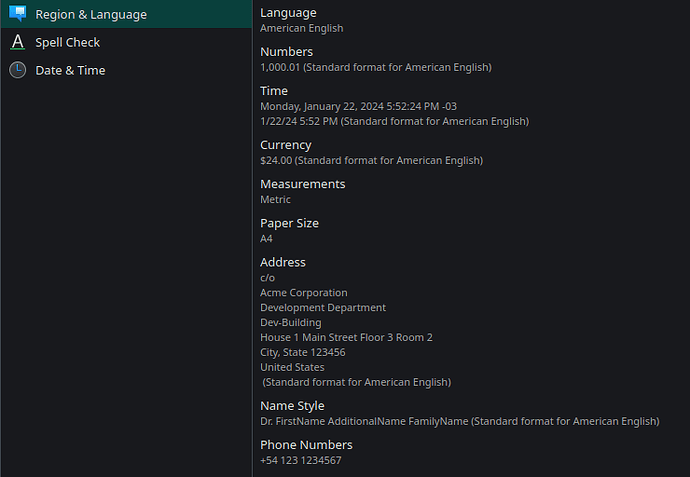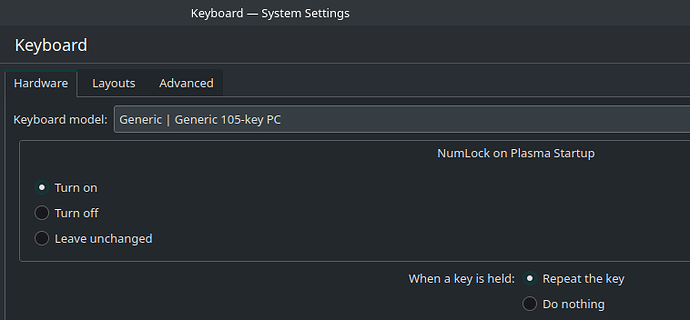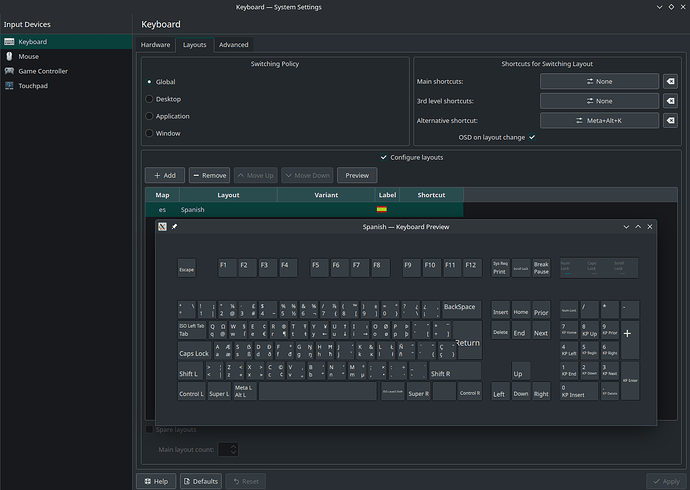Hi everybody, I’m new with Manjaro, and searching where to land when leaving Ubuntu I was quite happy so far about this new Manjaro installation ![]()
I’ve seen quite a few posts on this forum and elsewhere about problems with dead keys in Manjaro, alas none gave me a solution. (The default Spanish keyboard is great IMO because it allows to write in English, Spanish, Italian, French…)
Dead keys for accents were working fine, not now.
This is a 105-keys Spanish keyboard.
I have language en US and formats es AR.
For a reason which I’m going to mention below, I changed the language from US English to Spanish Argentina and back to US English.
I’ve spent almost three hours trying to get the dead keys working again, no success.
(Why did I do that: I downloaded a pdf file, in the terminal window its name appeared to be “Ficha técnica etc.pdf”, it was not being passed on correctly to evince, pdf reader, which was giving an error showing the parameter name with an escape sequence instead of the ‘é’ character, so I told to myself “let’s see what happens if instead of only the formats being set to Spanish Argentina I set the language as well to Spanish Argentina”, which didn’t solve the problem, and after getting back to my previous setup I realized that the dead keys were not working any more.)
I’ve already launched locale-gen, besides changing Manjaro and Plasma settings and rebooting a lot of times.
Current situation:
HEY dead keys ARE working HERE in Firefox, they are NOT working in LibreOffice Writer nor in Konsole (zsh terminal windows), but I could open the preformatted text zone without having to use the </> icon above here.
Content of /etc/locale.conf
LANG=en_US.UTF-8
LC_ADDRESS=es_AR.UTF-8
LC_IDENTIFICATION=es_AR.UTF-8
LC_MEASUREMENT=es_AR.UTF-8
LC_MONETARY=es_AR.UTF-8
LC_NAME=es_AR.UTF-8
LC_NUMERIC=es_AR.UTF-8
LC_PAPER=es_AR.UTF-8
LC_TELEPHONE=es_AR.UTF-8
LC_TIME=es_AR.UTF-8
Content of /locale.gen filtering out empty lines and commented out lines:
en_US.UTF-8 UTF-8
es_AR.UTF-8 UTF-8
~ > localectl
System Locale: LANG=en_US.UTF-8
LC_NUMERIC=es_AR.UTF-8
LC_TIME=es_AR.UTF-8
LC_MONETARY=es_AR.UTF-8
LC_PAPER=es_AR.UTF-8
LC_NAME=es_AR.UTF-8
LC_ADDRESS=es_AR.UTF-8
LC_TELEPHONE=es_AR.UTF-8
LC_MEASUREMENT=es_AR.UTF-8
LC_IDENTIFICATION=es_AR.UTF-8
VC Keymap: es
X11 Layout: es
X11 Model: pc105
~ > locale
LANG=en_US
LC_CTYPE="en_US"
LC_NUMERIC=es_AR.UTF-8
LC_TIME=es_AR.UTF-8
LC_COLLATE="en_US"
LC_MONETARY=es_AR.UTF-8
LC_MESSAGES="en_US"
LC_PAPER=es_AR.UTF-8
LC_NAME=es_AR.UTF-8
LC_ADDRESS=es_AR.UTF-8
LC_TELEPHONE=es_AR.UTF-8
LC_MEASUREMENT=es_AR.UTF-8
LC_IDENTIFICATION=es_AR.UTF-8
LC_ALL=
(related to the above snapshot: the image does not reflect the actual layout)
This preview reflects the actual layout of this keyboard and correctly reacts when I press the dead keys:
As mentioned above, everything works fine here in Firefox, not in LibreOffice Writer or Konsole windows (it was just fine everywhere, before):
TESTING dead keys in Firefox: áéíóú àèìòù ï ü ç []{}
WHAT AM I MISSING?
Thanks for reading and hopefully for the hints you’ll give me.






